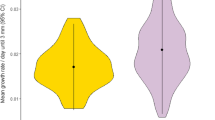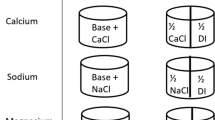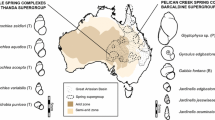Abstract
The freshwaters of Martinique (French West Indies) have recently been invaded by snails belonging to the Thiaridae family (Gastropoda; Prosobranchia). Eight distinct Thiarid lines have been successively introduced in Martinique, and are still in the process of sequentially replacing one another within local habitats, revealing a range of increasing invasive abilities. Our aim was to test whether the variation in invasive ability can be partly explained by a specific life-history trait, desiccation tolerance, which might be important in view of the typical instability of tropical freshwater habitats. We therefore tested desiccation tolerance in both juveniles and adults under laboratory conditions. Our data show that, although all Thiarid lines resist desiccation quite well, they exhibit extreme variation in the degree of tolerance. These differences are mostly mediated by individual size, but are definitely of genetic origin given that our individuals were of similar ages and were raised under standardized laboratory conditions. The overall invasive success of a line in Martinique, deduced from field surveys, does not correlate with its desiccation tolerance. However, desiccation tolerance does seem to be a limiting factor for the invasion of the small fraction of habitats that are most exposed to drought. More generally, our study exemplifies the possibility that the invasion differential among habitats, rather than a general invasion ability, be predicted according to a particular life-history trait, within a set of closely related invasive taxa.
Similar content being viewed by others
References
Abbott RT (1952) A study of an intermediate snail host (Thiara granifera) of the oriental lung fluke (Paragoninus). Proceedings of the US National Museum 102: 71–116
Appleton CC (1978) Review of literature on abiotic factors influenceing the distribution and life cycles of bilharziasis intermediate host snails. Malacological Review 11: 1–25
Barbosa FS and Barbosa I (1959) Observations on the ability of the snail Australorbis nigricans to survive out of the water in the laboratory. Journal of Parasitology 45: 627–630
Brown DS (1994) Freshwater Snails of Africa and their Medical Importance, 2nd edn. Taylor and Francis, London, 609 pp
Case TJ (1990) Invasion resistance arises in strongly interacting species-rich model competition communities. Proceedings of the National Academy of Sciences 87: 9610–9614.
Chaniotis BN, Miles Butler J, Ferguson FF and Jobin WR (1980) Thermal limits, desiccation tolerance, and humidity reactions of Thiara (Tarebia) granifera mauiensis (Gastropoda: Thiaridae) host of the Asiatic lung fluke disease. Caribbean Journal of Sciences 16: 1–4
Crawley MJ (1993) GLIM for ecologists. Blackwell Scientific Publications, Oxford
Cridland CC (1967) Resistance of Bulinus (Physopsis) globosus, Bulinus (Ph.) africanus, Biomphalaria pfeifferi and Lymnaea natalensis to experimental desiccation. Bulletin of the World Health Organization 36: 507–513
Dudgeon D (1980) The Corbiculidae of Southern China. In: Morton BS (ed) Proceedings, First International Workshop on the Malacofauna of Hong Kong and southern China, 37–60. Hong Kong University Press
Dudgeon D (1981) Aspects of the desiccation tolerance of four species of benthic mollusca from plover cove reservoir, Hong Kong. The Veliger 24: 267–271
Everett RA (2000) Patterns and pathways of biological invasions. Trends in Ecology and Evolution 15: 177–178
Fausch KD, Taniguchi Y, Nakano S, Grossman GD and Townsend CR (2001) Flood disturbance regimes influence rainbow trout invasion success among five holartic regions. Ecological Applications 11: 1438–1455
Hacker SD, Heimer D, Hellquist CE, Reeder TG, Reeves B, Riordan TJ and Dethier MN (2001) A marine plant (Spartina anglica) invades widely varying habitats: potential mechanisms of invasion and control. Biological Invasions 3: 211–217
Hill AM, Sinars DM and Lodge DM (1993) Invasion of an occupied niche by the crayfish Orconectes rusticus: potential importance of growth and mortality. Oecologia 94: 303–306
Holway DA, Suarez AV and Case TJ (2002) Role of abiotic factors in governing susceptibility to invasion: a test with argentine ants. Ecology 83: 1610–1619
Jabbour-Zahab R, Pointier JP, Jourdane J, Oviedo J, Bargues MD, Mas-Coma S, Angles R, Perera G, Khallayoune K and Renaud F (1997) Phylogeography and genetic divergence of some lymnaeid snails, intermediate hosts of human and animal fasciolasis with special reference to lymnaeids from the Bolivian Altiplano. Acta Tropica 64: 191–203
Jacob J (1958) Cytological studies of Melaniidae (Mollusca) with special reference to parthenogenesis and polyploidyII. A study of meiosis in the rare males of the polyploid race M. tuberculata and M. ilineatus. Transactions of the Royal Society of Edinburgh 63: 433–444
Jarne P and St¨ adler T (1995) Population genetic structure and mating system evolution in freshwater pulmonates. Experimentia 51: 482–497
Kolar CS and Lodge DM (2001) Progress in invasion biology: pppredicting invaders. Trends in Ecology and Evolution 16: 199–204
Levine JM (2000) Species diversity and biological invasions: relating local process to community patterns. Science 288: 852–854
Lockwood JL (1999) Using taxonomy to predict success among introduced avifauna: relative importance of transport and establishment. Conservation Biology 13: 560–567
Machin J (1975) Water relations. In: Fretter and Peake J (eds) Pulmonates, Vol I: Functional Anatomy and Physiology, pp 105–163. Academic Press, London
Maguire Jr B(1963) The passive dispersal of small aquatic organisms and their colonization of isolated bodies of water. Ecological Monographs 33: 161–185
McCullagh HP and Nelder JA (1983) Generalized Linear Models. Cambridge University Press, Cambridge, UK, 511 pp
Miller TE, Kneitel JM and Burns JH (2002) Effect of community structure on invasion success and rate. Ecology 83: 898–905
Moyle PB and Light T (1996) Fish invasions in California: do abiotic factors determine success? Ecology 77: 1666–1670
Pointier JP (1989) Conchological studies of Thiara (Melanoides) tuberculata (mollusca: gastropoda: thiaridae) in the French West Indies. Walkerana 3: 203–209
Pointier JP (1993) The introduction of Melanoides tuberculata (Mollusca: Thiaridae) to the island of Saint Lucia (West Indies) and its role in the decline of Biomphalaria glabrata, the snail intermediate host of Schistosomia mansoni. Acta Tropica 54: 13–19
Pointier JP (1999) Invading freshwater gastropods: some conflicting aspects for public health. Malacologia 41: 403–411
Pointier JP (2001) Invading freshwater snails and biological control in Martinique Island, French West Indies. Memorias do Instituto Oswaldo Cruz 96: 67–74
Pointier JP and Combes C (1976) La saison sèche en Guadeloupe et ses consèquences sur la dèmographie des mollusques dans les biotopes ' a Biomphalaria glabrata (Say, 1818), vecteur de la bilharziose intestinale. Terre et Vie 30: 121–147
Pointier JP and McCullough F (1989) Biological control of the snail hosts of Schistosoma mansoni in the Caribbean area using Thiaras pp. Acta Tropica 46: 147–155
Pointier JP, Delay B, Toffart JL, Lefèvre M and Romero-Alvarez R (1992) Life history traits of three morphs of Melanoides tuberculata (Gastropoda: Thiaridae), an invading snail in the French West Indies. Journal of Molluscan Studies 58: 415–423
Pointier JP, Thaler L, Pernot AF and Delay B (1993) Invasion of the Martinique island by the parthenogenetic snail Melanoides tuberculata and the succession of morphs. Acta Oecologica 14: 33–42
Rahel FJ (2000) Homogenization of fish faunas across the United States. Science 288: 854–856
Ricciardi A and MacIsaac HJ (2000) Recent mass invasion of the North American great lakes by Ponto-Caspian species. Trends in Ecology and Evolution 15: 62–65
Reeve L (1860) Conchologica Iconica or illustrations of the shells of molluscous animals. Vol. 12, Pl. 33, Fig. 223
Rosecchi E, Thomas F and Crivelli AJ (2001) Can life-history traits predict the fate of introduced species? A case study on two cyprinid fish in southern France. Freshwater Biology 46: 845–853
Ross RM, Lellis WA, Bennett RM and Johnson CS (2001) Landscape determinants of non indigenous fish invasions. Biological Invasions 3: 347–361
Sakai AK, Allendorf FW and Holt JS et al. (2001) The population biology of invasive species. Annual Review of Ecology and Systematics 32: 305–332
Sall J and Lehman A (1996) JMP, start statistics: a guide to statistics and data analysis using JMP and JMP IN ® Software. Duxbury Press, 521 pp
Samadi S, Mavarez J, Pointier JP, Delay B and Jarne P (1999) Microsatellite and morphological analysis of population structure in the parthenogenetic freshwater snail Melanoides tuberculata: insights into the creation of variability. Molecular Ecology 8: 1141–1153
Sokal RR and Rohlf FJ (1995) Biometry 3rd edn. WH Freeman & Company, New York, 887 pp
Stoddart JA (1985) Analysis of species lineages of some Australian thiarids (Thiaridae, Prosobranchia, Gastropoda) using the evolutionary species concept. Journal of Malacological Society of Australia 7: 7–16
Sturrock RF (1970) An investigation of some factors influencing the survival of St Lucian Biomphalaria glabrata deprived of water. Annals of Tropical Medicine and Parasitology 64: 365–371
Tilman D(1997) Community invasibility, recruitment limitation, and grassland biodiversity. Ecology 78: 81–92
Tucker JK, Janzen FJ and Paukstis GL (1996) Laboratory survivorship of aerially exposed pond snails (Physella integra) from Illinois. Transaction of the Illinois State Academy of Science 89: 225–231
Vèra C, Brèmond P, Labbo R, Meuchet F, Sellin E, Boulanger D, Pointier JP, Delay B and Sellin B (1994) Seasonal fluctuations in population densities of Bulinus senegalensis and B. truncates (Planorbidae) in temporary pools in a focus of Schistosoma haematobium in Niger: implications for control. Journal of Molluscan Studies 61: 79–88
Welcomme RL (1992) A history of international introductions of inland aquatic species. ICES Marine Science Symposia 194: 3–14
Williamson MH and Fitter A (1996a) The characters of successful invaders. Biological Conservation 78: 163–170
Williamson MH and Fitter A (1996b) The varying success of invaders. Ecology 77: 1661–1666
Author information
Authors and Affiliations
Corresponding author
Rights and permissions
About this article
Cite this article
Facon, B., Machline, E., Pointier, J. et al. Variation in Desiccation Tolerance in Freshwater Snails and Its Consequences for Invasion Ability. Biological Invasions 6, 283–293 (2004). https://doi.org/10.1023/B:BINV.0000034588.63264.4e
Issue Date:
DOI: https://doi.org/10.1023/B:BINV.0000034588.63264.4e




